The average gas consumption for heating a house is 150 m²: an example of calculations and an overview of heat engineering formulas
Financing the heating season is a significant part of the budget spent on housing maintenance. Knowing the price and average gas consumption for heating a house 150 m2, you can accurately determine the cost of heating the premises. These calculations are easy to do on their own without paying for the services of heat engineers.
You will learn all about gas consumption standards and methods for calculating gas consumption from our article. We will talk about how much energy is needed to compensate for the heat loss of a house during the heating season. Let’s show you what formulas should be used in calculations.
The content of the article:
Heating of country cottages
When calculating the gas flow rate that is needed to heat a house, the most difficult task will be heat loss calculation, which must be fully compensated by the heating system during operation.
The complex of heat losses depends on the climate, the design features of the building, the materials used and the parameters of the ventilation system.
Calculation of compensated heat
The heating system of any building should compensate for its heat loss Q (W) in the cold period. They occur for two reasons:
- heat transfer through the perimeter of the house;
- heat loss due to cold air entering through the ventilation system.
Formally, heat loss through the wall and roof Qtp can be calculated using the following formula:
Qtp = S * dT / R,
Where:
- S - surface area (m2);
- dT - temperature difference between indoor and outdoor air (° C);
- R - an indicator of resistance to heat transfer of materials (m2 * ° C / W).
The last indicator (also called the “coefficient of thermal resistance”) can be taken from the tables attached to building materials or products.
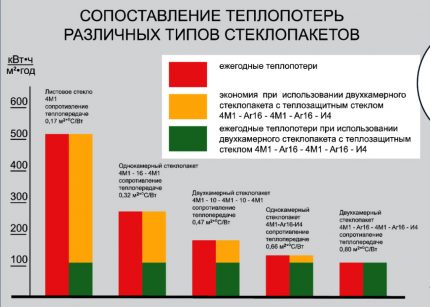
Example. Let the outer wall of the room have an area of 12 m2of which 2 m2 takes a window.
The indicators of resistance to heat transfer are as follows:
- Aerated concrete blocks D400: R = 3.5.
- Double-glazed window double-chamber with argon “4M1 - 16Ar - 4M1 - 16Ar - 4I": R = 0.75.
In this case, at room temperature “+ 22 ° C”, and outdoor - “–30 ° C” the heat loss of the outer wall of the room will be:
- Qtp (wall) = 10 * (22 - (- 30)) / 3.5 = 149 W:
- Qtp (window) = 2 * (22 - (- 30)) / 0.75 = 139 W:
- Qtp = Qtp (wall) + Qtp (window) = 288 watts.
This calculation gives the correct result if there is no uncontrolled air exchange (infiltration).
It can occur in the following cases:
- The presence of structural defects, such as loose fit of window frames to the walls or peeling of insulation material. They must be eliminated.
- Aging of the building, as a result of which chips, cracks or voids form in the masonry. In this case, it is necessary to introduce correction factors in the indicator of heat transfer resistance of materials.
In the same way, it is necessary to determine the heat loss through the roof, if the object is located on the top floor. Through the floor, any significant loss of energy occurs only if there is an unheated, blown-out basement, such as a garage. Heat hardly leaves the earth.
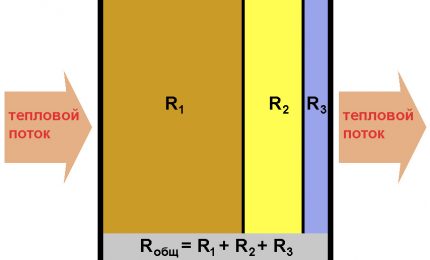
Consider the second reason for heat loss - the ventilation of the building. Energy consumption for heating the supply air (Qat) can be calculated by the formula:
Qat = L * q * c * dTwhere:
- L - air consumption (m3 / h);
- q - air density (kg / m3);
- c - specific heat of the incoming air (kJ / kg * ° C);
- dT - temperature difference between indoor and outdoor air (° C).
The specific heat of air in the temperature range of interest to us [–50 .. +30 ° С] is equal to 1.01 kJ / kg * ° С or in terms of the required dimension: 0.28 W * h / kg * ° С. Air density depends on temperature and pressure, but for calculations you can take a value of 1.3 kg / m3.
Example. For room 12 m2 with the same temperature difference as in the previous example, heat losses due to ventilation work will be:
Qat = (12 * 3) * 1.3 * 0.28 * (22 - (- 30)) = 681 W.
Designers take air flow according to SNiP 41-01-2003 (in our example 3 m3 / h at 1 m2 living room area), but this value can be significantly reduced by the owner of the building.
Total total heat loss of the model room is:
Q = Qtp + Qat = 969 watts
To calculate the heat loss per day, week or month, you need to know the average temperature for these periods.
From the above formulas it is clear that the calculation of the volume of gas consumed both for a short period of time and for the entire cold season must be carried out taking into account the climate of the area where the heated object is located. Therefore, it is possible to use well-proven standard solutions only for similar environmental conditions.
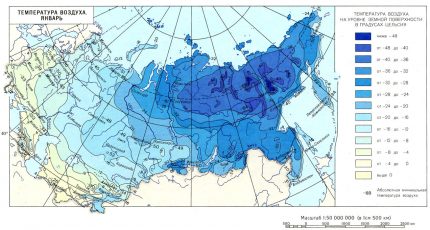
With the complex geometry of the house and the variety of materials used in its construction and insulation, you can use the services of specialists to calculate the required amount of heat.
Ways to minimize heat loss
The cost of heating a house is a significant part of the cost of its maintenance. Therefore, it is reasonable to perform some types of work aimed at reducing heat loss by ceiling insulationthe walls of the house floor insulation and related designs.
Application insulation schemes outside and inside the house can significantly reduce this figure. This is especially true of old buildings with strong wear of walls and floors. The same polystyrene foam plates allow not only to reduce or completely eliminate freezing, but also minimize air infiltration through the protected coating.
Significant savings can also be achieved if the summer areas of the house, such as the veranda or the attic, are not connected to the heating. In this case, there will be a significant reduction in the perimeter of the heated part of the house.
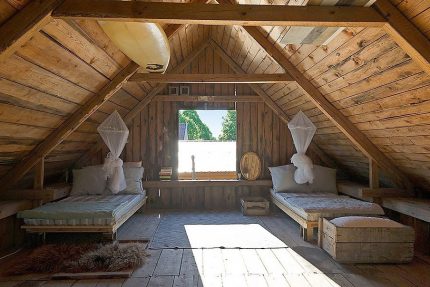
If you strictly follow the ventilation standards of the premises, which are prescribed in SNiP 41-01-2003, then the heat loss from air exchange will be higher than from freezing of the walls and roof of the building. These rules are mandatory for designers and any legal entities if the premises are used for production or the provision of services. However, the residents of the house may, at their discretion, reduce the values indicated in the document.
In addition, heat exchangers can be used to heat cold air coming in from the street, rather than appliances that consume electricity or gas. So an ordinary plate heat exchanger can save more than half the energy, and a more complex device with a coolant can save about 75%.
Calculation of the required volume of gas
Combustible gas must compensate for heat loss. For this, in addition to the heat loss at home, it is necessary to know the amount of energy released during combustion, which depends on the efficiency of the boiler and the calorific value of the mixture.
Boiler selection rule
The choice of heater must be carried out taking into account the heat loss at home. It should be enough for the period when the annual minimum temperature is reached. In the passport or wall mounted gas boiler the “nominal thermal power” parameter, which is measured in kW for household appliances, is responsible for this.
Since any structure has thermal inertia, for calculating the necessary boiler capacity for the minimum temperature, the indicator of the coldest five-day period is usually taken. For a particular area, it can be found in organizations involved in the collection and processing of weather information, or from table 1. SNiP 23-01-99 (column No. 4).

If the boiler power exceeds the indicator sufficient for heating the room, then this does not lead to an increase in gas consumption. In this case, the equipment downtime will be longer.
Sometimes there is a reason to choose a boiler of slightly lower power. Such devices can be much cheaper when buying and operating. However, in this case, it is necessary to have a spare heat source (for example, a heater with a gas generator), which can be used in severe frosts.
The main indicator of the efficiency and efficiency of the boiler is the efficiency. For modern household equipment, it ranges from 88 to 95%. The efficiency is registered in the passport of the device and it is used in calculating gas consumption.
Heat release formula
To correctly calculate the consumption of natural or liquefied gas for heating a house with an area of about 150 m2 you need to know another indicator - the calorific value (specific heat of combustion) of the supplied fuel. According to the SI system, it is measured in J / kg for liquefied gas or in J / m3 for natural.

There are two values of this indicator - lower calorific value (Hl) and higher (Hh) It depends on the humidity and temperature of the fuel. When calculating take an indicator Hl - You need to find it out from the gas supplier.
If there is no such information, then in the calculations you can take the following values:
- for natural gas Hl = 33.5 mJ / m3;
- for liquefied gas Hl = 45.2 mJ / kg.
Given that 1 mJ = 278 W * h, we obtain the following calorific values:
- for natural gas Hl = 9.3 kW * h / m3;
- for liquefied gas Hl = 12.6 kW * h / kg.
Volume of gas consumed over a certain period of time V (m3 or kg) can be calculated using the following formula:
V = Q * E / (Hl * K)where:
- Q - heat loss of the building (kW);
- E - duration of the heating period (h);
- Hl - minimum calorific value of gas (kW * h / m3);
- K - boiler efficiency.
For liquefied gas, dimension Hl equal to kW * h / kg.
Example of calculating gas consumption
For example, take a typical prefabricated frame wooden two-story cottage. Region - Altai Territory, Barnaul.
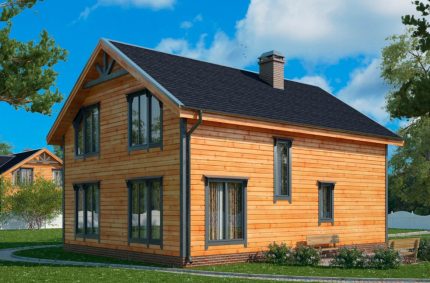
Step 1. We calculate the main parameters of the house for calculating heat loss:
- Floor. In the absence of a purged basement, losses through the floor and foundation can be neglected.
- Window. Double-glazed window double-chamber "4M1 - 16Ar - 4M1 - 16Ar - 4I": Ro = 0.75. Glazing area So = 40 m2.
- Walls. The area of the longitudinal (side) wall is 10 * 3.5 = 35 m2. The area of the transverse (front) wall is 8.5 * 3.5 + 8.52 * tg(30) / 4 = 40 m2. Thus, the total perimeter of the building is 150 m2, and taking into account the glazing, the desired value Ss = 150 - 40 = 110 m2.
- Walls. The main heat-insulating materials are glued beam, 200 mm thick (Rb = 1.27) and basalt insulation, 150 mm thick (Ru = 3.95). The total heat transfer resistance for the wall Rs = Rb + Ru = 5.22.
- Roof. Warming completely repeats the shape of the roof. Roof area without overhangs Sk = 10 * 8.5 / cos (30) = 98 m2.
- Roof. The main heat-insulating materials are lining, 12.5 mm thick (Rv = 0.07) and basalt insulation, 200 mm thick (Ru = 5.27). The total heat transfer resistance for the roof Rk = Rv + Ru = 5.34.
- Ventilation. Let the air flow rate be calculated not according to the area of the house, but taking into account the requirements, ensure a value of at least 30 m3 per person per hour. Since the cottage is constantly inhabited by 4 people, then L = 30 * 4 = 120 m3 / h
Step. 2. We calculate the required boiler power. If the equipment has already been purchased, then this step can be skipped.
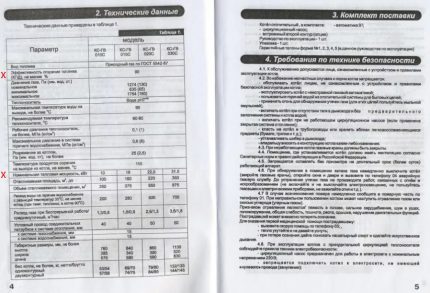
The temperature of the coldest five-day period is “–41 ° C". We will take a comfortable temperature as “+24 ° С". Thus, the average temperature difference over this period will be dT = 65 ° C.
We calculate the heat loss:
- through the windows: Qo = So * dT / Ro = 40 * 65 / 0.75 = 3467 W;
- through the walls: Qs = Ss * dT / Rs = 110 * 65 / 5.22 = 1370 W;
- through the roof: Qk = Sk * dT / Rk = 98 * 65 / 5.34 = 1199 W;
- due to ventilation: Qv = L * q * c * dT = 120 * 1.3 * 0.28 * 65 = 2839 W.
The total heat loss of the whole house during the cold five-day period will be:
Q = Qo + Qs + Qk + Qv = 3467 + 1370 + 1199 + 2839 = 8875 W.
Thus, for this model house, you can choose a gas boiler with a maximum thermal power parameter of 10-12 kW. If gas is also used to provide hot water, you will have to take a more productive device.
Step 3 We calculate the duration of the heating period and the average heat loss.
Under the cold season, when heating is necessary, understand the season with daily average temperatures below 8-10 ° C. Therefore, for calculations, you can take either columns No. 11-12 or columns No. 13-14 of Table 1 of SNiP 23-01-99.
This choice is left to the owners of the cottage. In this case, there will be no significant difference in annual fuel consumption. In our case, we will dwell on a period with a temperature below “+ 10 ° C”. The duration of this period is 235 days or E = 5640 hours.
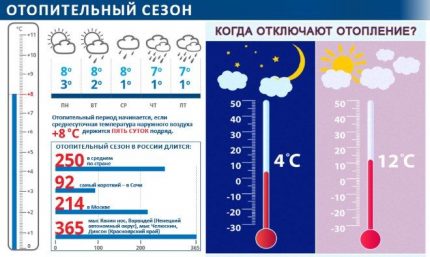
The heat loss of the house for the average temperature for this period is calculated as in step 2, only the parameter dT = 24 - (- 6.7) = 30.7 ° С. After performing the calculations, we obtain Q = 4192 watts.
Step 4 We calculate the amount of gas consumed.
Let the boiler efficiency K = 0.92. Then the volume of gas consumed (with averaged indicators of the minimum calorific value of the gas mixture) for the cold period of time will be:
- for natural gas: V = Q * E / (Hl * K) = 4192 * 5640 / (9300 * 0.92) = 2763 m3;
- for liquefied gas: V = Q * E / (Hl * K) = 4192 * 5640 / (12600 * 0.92) = 2040 kg.
Knowing the price of gas, you can calculate the financial costs of heating.
Conclusions and useful video on the topic
Reducing gas consumption by eliminating errors associated with home insulation. Real example:
Gas flow at known heat output:
All calculations of heat loss can be carried out independently only when the heat-saving properties of the materials of which the house is built are known. If the building is old, then first of all it is necessary to check it for freezing and eliminate the identified problems.
After that, using the formulas presented in the article, it is possible to calculate the gas flow with high accuracy.
Please leave comments in the feedback box below. Post a photo on the topic of the article, ask questions about interested points. Share useful information that may be useful to visitors to our site.

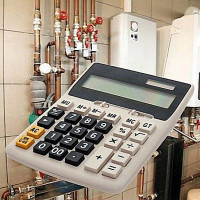 Gas consumption for heating a house 100 m²: calculation features for liquefied and natural gas + examples with formulas
Gas consumption for heating a house 100 m²: calculation features for liquefied and natural gas + examples with formulas 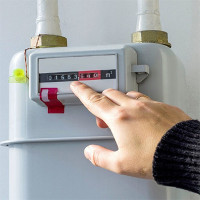 Gas consumption for heating a house 200 m²: determination of costs when using main and bottled fuel
Gas consumption for heating a house 200 m²: determination of costs when using main and bottled fuel 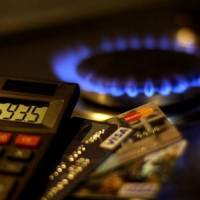 How to calculate gas consumption for heating a house in accordance with the norms
How to calculate gas consumption for heating a house in accordance with the norms 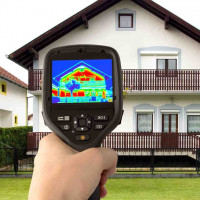 Thermotechnical calculation of a building: specifics and formulas for performing calculations + practical examples
Thermotechnical calculation of a building: specifics and formulas for performing calculations + practical examples 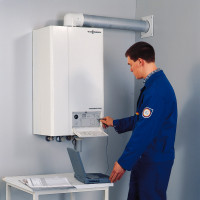 How to calculate the power of a gas heating boiler: formulas and calculation example
How to calculate the power of a gas heating boiler: formulas and calculation example 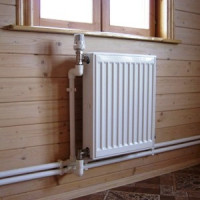 How to arrange the heating of a private house with your own hands: schemes for organizing an autonomous heating system
How to arrange the heating of a private house with your own hands: schemes for organizing an autonomous heating system  How much does it cost to connect gas to a private house: the price of organizing gas supply
How much does it cost to connect gas to a private house: the price of organizing gas supply  The best washing machines with dryer: model rating and customer tips
The best washing machines with dryer: model rating and customer tips  What is the color temperature of light and the nuances of choosing the temperature of the lamps to suit your needs
What is the color temperature of light and the nuances of choosing the temperature of the lamps to suit your needs  Replacement of a geyser in an apartment: replacement paperwork + basic norms and requirements
Replacement of a geyser in an apartment: replacement paperwork + basic norms and requirements